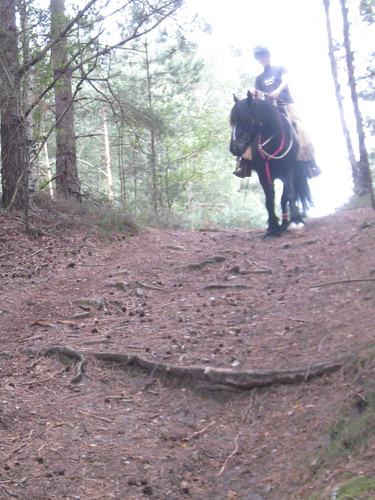This is almost a one-liner- a really simple rule, but if you maintain it you will find that your horse works really well. It seems totally obvious that you don’t want your horse to pull on you, but I very rarely see a horse that doesn’t and I think this is partly because people don’t always recognise when their horse is pulling. I’ll list a few of the situations that I can think of:
- If I am leading my horse and the rope gets straight, they are pulling on me.
- If I start walking with my horse and they don’t start walking too, they are pulling on me.
- If I pick up the rein or lead rope laterally and my horse doesn’t immediately bend smoothly in the direction of the pressure I am creating, they are pulling on me.
- If I place one finger on one side of the lead rope on my horse’s halter under their chin and gently push the knot and the horse doesn’t follow that pressure, my horse is pulling on me.
- If I reach for my horse down the rein or the lead rope and my horse doesn’t reach back, my horse is pulling on me.
This can be summed up very simply: If my lead rope ( or rein ) gets fully straight, my horse is pulling on me.
How do you teach a horse not to pull on you? The trick of it is as simple as the rule itself, but us horsepeople seem to have a real problem with it, especially here in the UK. All you do is never pull on your horse. A horse that never gets pulled on never learns to pull. As Steve Halfpenny is fond of reminding us, they aren’t born with handles on them. Horses only ever get pulled around in their interactions with us, so if we don’t teach them to pull, they won’t do it.

What is the alternative to pulling? There are a few things one can do, all somewhat easier to show than to describe, but I’ll give it my best shot:
You can put a feel on the rope. This may sound the same as pulling it is how ask for a change through the rope- I expect it to come into operation before the rope comes taut. If you want to experiment with this, hold one end of a rope and have a friend hold the other. Close your eyes and ask your friend to pick up the rope slowly in one direction or another. Tell them to stop when you feel it, then open your eyes. There will almost certainly be a big loop in the rope. Your horse can feel that at least as easily as you can. When I pick up a lead rope or a rein like this, I expect my horse to follow that feel. They may not do, but I have found that if I don’t expect it, they probably won’t do it. Often people just end up over-asking and doing too much.
If I have picked up a feel on the rope or the reins and nothing is happening I might try something else to ask the horse to follow it- this goes back to Energy Is Not Direction – so I might slap my leg or swing the other end of the rope ( being very careful that it doesn’t interfere with the steady feel I am presenting down the rope ) to ask the horse to look for something instead of ignoring what I am asking for. This works well both in the saddle and on the ground.
I might also, without releasing my initial request, take my other hand across and bump on rein I am holding. This is another way of creating a consequence to ignoring my initial request as far as my horse is concerned and I certainly wouldn’t do it if I felt they were looking for an answer, but if they were happy to set down and lean on the rein it can be a way of waking them up and a bump is something a horse can’t pull back against. By using my other hand, I avoid releasing the initial request, so the horse isn’t getting a confusing release followed by a bump.
If a horse is resisting the feel I present down the rein ( and I do this more from the saddle but it would work fine from the ground ) I will sometimes just search at the quietest level I can for where the resistance begins, which will always be on one rein or the other- never both, then gently experiment with my hand position and changing the feel I present until the horse releases to it. This is quite subtle, but it seems to be helpful to a lot of horses.
Sometimes if a horse is leaning on the rein you can use the terrain to your advantage- rather than getting into an argument or a pulling match if there is a fence available you can use that to help your horse to steer off a lighter feel by closing down one of their options. Once they have the idea of it and you have the sensation in your body, you will probably find that they can do it everywhere.
One thing that goes with this being an absolute rule is that I prioritise it the whole time- if I am working on something else and my horse starts to pull, I immediately fix the pull before I go back to the work I was doing.
A horse who is pulling is leaving without me, and I just don’t want that to happen.




